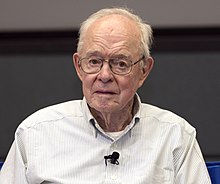Eugene Parker | |
|---|---|
 Parker in 2018 at the launch of the solar probe that bears his name | |
| Born | Eugene Newman Parker June 10, 1927 Houghton, Michigan, U.S. |
| Died | March 15, 2022 (aged 94) Chicago, Illinois, U.S. |
| Nationality | American |
| Alma mater | Michigan State University (BS) Caltech (PhD) |
| Known for | Sweet–Parker model Solar wind Parker spiral |
| Awards | Arctowski Medal (1969) George Ellery Hale Prize (1978) Chapman Medal (1979) National Medal of Science (1989) William Bowie Medal (1990) James Clerk Maxwell Prize (2003) Kyoto Prize (2003) Crafoord Prize (2020) |
| Scientific career | |
| Fields | Solar physics, plasma physics |
| Institutions | University of Chicago |
| Thesis | The interstellar dust and gas structures (1951) |
| Doctoral advisor | Howard P. Robertson |
| Doctoral students | Arnab Rai Choudhuri |
Eugene Newman Parker (June 10, 1927 – March 15, 2022) was an American solar and plasma physicist. In the 1950s he proposed the existence of the solar wind and that the magnetic field in the outer Solar System would be in the shape of a Parker spiral, predictions that were later confirmed by spacecraft measurements. In 1987, Parker proposed the existence of nanoflares, a leading candidate to explain the coronal heating problem.
Parker obtained his PhD from Caltech and spent four years as a postdoctoral researcher at the University of Utah. He joined University of Chicago in 1955 and spent the rest of his career there, holding positions in the physics department, the astronomy and astrophysics department, and the Enrico Fermi Institute. Parker was elected to the National Academy of Sciences in 1967. In 2017, NASA named its Parker Solar Probe in his honor, the first NASA spacecraft named after a living person.[1]
